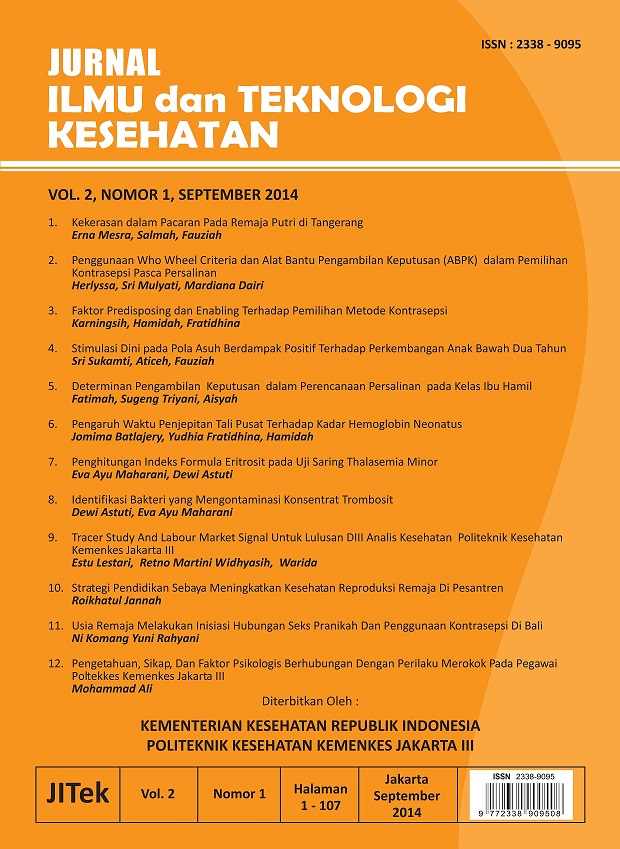Main Article Content
Abstract
Thalassemia is a genetic disorder caused by impaired synthesis of globin chains in hemoglobin (Hb) molecule which can be partial or total. Since thalassemia is inherited from parents to their children, screening is compulsory to prevent newborn at risk from major thalassemia. The incidence thalassemia cases can be found around the world but majority cases emerge among Mediterranean, easter, and Asian. Thalassemia minor is diagnosed based on erythrocyte indices and confirmed by molecular analysis of Hb and DNA. Currently, several formulas are developed to identify the existence of thalassemia. This cross sectional study was aimed to know how good the formulas is. Thalassemia screening was done to 138 donors with minimum of Hb 12,5 g/dL. Detection and identification proses was conducted by the use of calculation index formulas for erythrocytes namely Mentzer index, Srivastava, Shine & Lal, and England & Fraser. The results showed that all of four indexes can detect ? thalassemia minor. The highest degree of sensitivity is Mentzer and Shine & Lal indexs (100%), whereas the highest specificity is Srivastava index (100%). In addition, ? thalassemia and Hb variant (HbE) can also be detected, although not 100%. This result shows that the formulas can be used as a screening of thalassemia, especially in areas those have no access
to molecular laboratory.
Keywords
Article Details
Authors who publish with this journal agree to the following terms:
1. Authors retain copyright and grant the journal right of first publication with the work simultaneously licensed under a Creative Commons Attribution-ShareAlike License that allows others to share the work with an acknowledgment of the work's authorship and initial publication in this journal.
2. Authors are able to enter into separate, additional contractual arrangements for the non-exclusive distribution of the journal's published version of the work (e.g., post it to an institutional repository or publish it in a book), with an acknowledgment of its initial publication in this journal.
3. Authors are permitted and encouraged to post their work online (e.g., in institutional repositories or on their website) prior to and during the submission process, as it can lead to productive exchanges, as well as earlier and greater citation of published work (See The Effect of Open Access).
References
-
Ahmed, N., Dawson, M., Smith, C., & Wood. 2007. Biology of disease, T & F informa, UK.
Au W.Y, & Liang, R. 2007. 'Thalassemia management in Hong Kong', ISBT science series, vol.2, p:160-166.
Bain, B.J. 2006. Blood cells a practical guide. 4th ed., Australia: Blackwell publishing.
Higgs, D.R., Olivieri, N.F., & Weatherall, D.J. 2009, Disorders of hemoglobin, Genetics, Patophysiology, and clinical management 2nd ed, eds. Steinberg MH, Forget BG, Higgs DR, & Weatherall DJ, Cambridge University Press, UK.
Judd, S. J. 2010. Health reference series, genetic disorders sourcebook. 4th ed. USA: Omniographics.
Fucharoen S., et.al. 1998. Prenatal and postnatal diagnoses of thalasemias and hemoglobinopathies by HPLC. Clinical chemistry, Vol.44, No.4 :740-747.
Kohne, E. 2011. Hemoglobinopaties clinical manifestation, diagnosis, and treatment. Dtsch Arztebl Int, Vol.108, No.31-32 : 532-540.
Muncie, H. L., & Campbell, J. S. 2009. alpha and beta thalassemia. American family physician, vol.80, no.4, p: 339-344.
Niazi, M., Tahir, M., Raziq, F.E. & Hameed, A. 2010. Usefulness of red cell indices in differentiating microcytic hypochromic anemias. Gomal Journal of Medical Sciences, vol.8, no.2, p:.125-129.
Rathod, D.A., et.al. 2007. Usefulnes of cell counter-based and formulas in detection of ?-thalasemia trait in areas of high prevalence. American society for clinical pathology, vol.128, p:.585-589.
Rogers, K. 2011. The human body, blood physiology and circulation, New York USA : Britannica educational publishing.
Sacher, R.A., & McPherson, R.A. 2004. Tinjauan klinis hasil pemeriksaan laboratorium.Ed. Hartanto, H. Jakarta: EGC.
